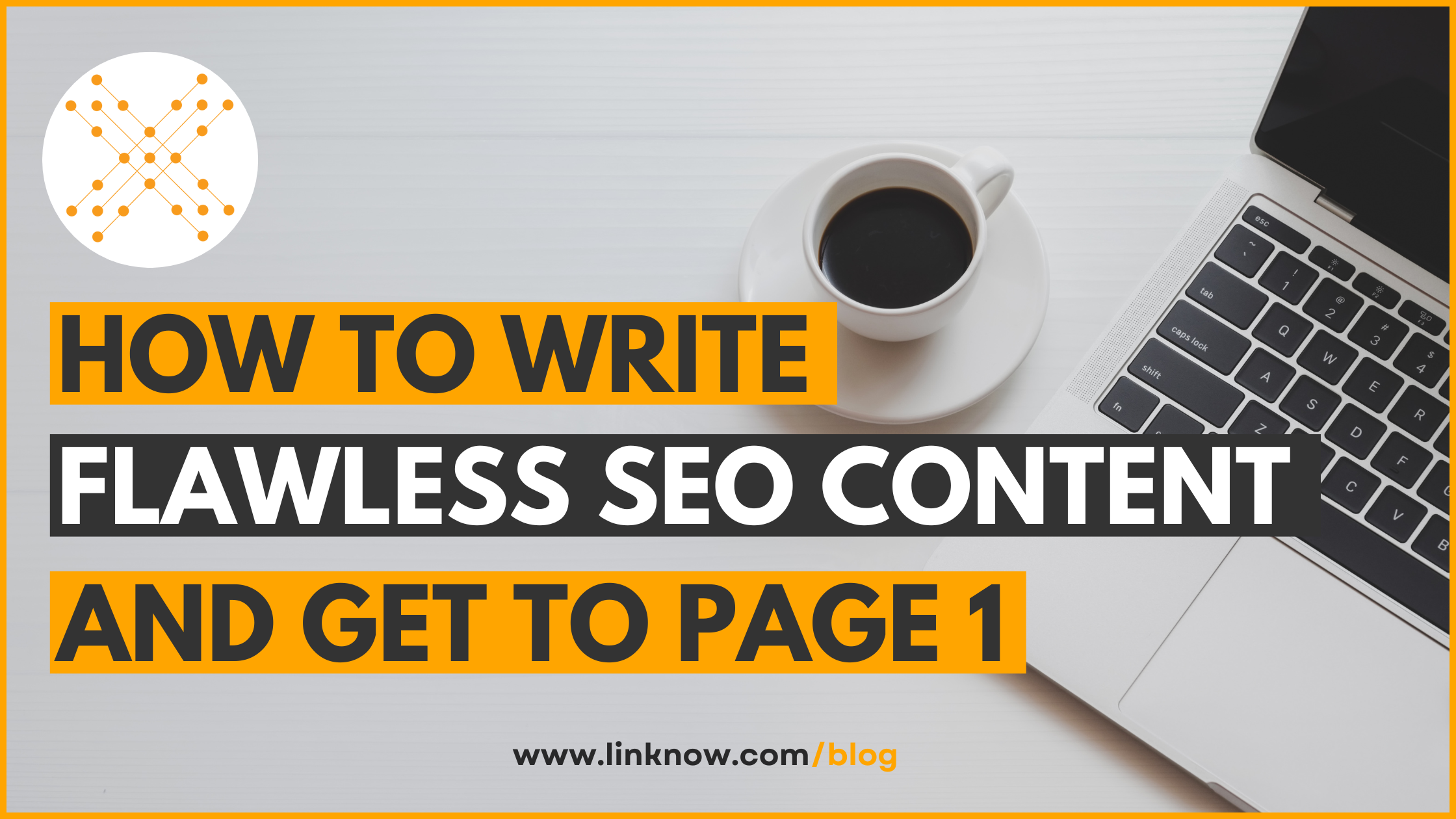
Having a strong online presence is essential for any business or individual looking to thrive in today’s market, and there’s no better way to enhance your visibility than by mastering the art of search engine optimization (SEO).
By knowing the secrets of writing killer SEO content, you can catapult your website to the coveted first page of search engine results.
In this detailed guide, the content specialists at LinkNow will explain the strategies, techniques, and best practices for crafting compelling content that captivates your audience and helps your site rank higher on search engine result pages (SERPs).
By the time you’re done reading, you’ll be ready to unlock the power of SEO and take your website to new heights of success.
What is SEO Content?
SEO content is written with the goal of providing the best user experience and increasing a website’s visibility in search engine results.
Search engine optimization is a strategy that involves optimizing web content to rank well in search engine results pages. This type of content is strategically designed to include relevant keywords, which are terms and phrases that users commonly type into search engines when looking for information.
Effective SEO content incorporates these keywords naturally while delivering valuable information in a user-friendly format. It often includes optimized headers, meta descriptions, and images to enhance readability and engagement.
Through improving a site’s SEO, content helps attract more organic traffic, which leads to increased awareness, customer engagement, and conversions for businesses or services.
Why Is Search Engine Optimization Important?
Effective search engine optimization positions your business as an industry authority and helps enhance your online presence by ensuring your content ranks well for relevant queries. Users tend to trust sites that appear at the top of their search results, so a high ranking increases your brand’s visibility and lends credibility to your business.
When your website consistently appears for industry-specific keywords, your business establishes itself as a knowledgeable and reliable source within your field.
Effective SEO involves creating high-quality, informative content that addresses the needs and questions of your audience, further reinforcing your expertise and authority. This ongoing process of optimization and content creation fosters trust and loyalty among users, setting your business apart as a leader in your field.
Conducting Keyword Research
Conducting keyword research is a fundamental step in crafting SEO-friendly web content.
Here’s how you can isolate the best search terms to incorporate into your web content:
Define Your Objectives
Start by clearly defining your website or specific web page’s goals. Understand your target audience, what information they might be seeking, and what search terms they might use.
Brainstorm Initial Keywords
List potential keywords that relate to your content, products, or services. Think about the phrases your customers might use when searching for your offerings. Include both broad and specific terms.
Use Keyword Research Tools
Leverage tools like Google Keyword Planner, SEMrush, Ahrefs, or Moz Keyword Explorer. These tools provide insights on keyword volume (how many people search for the keyword), competition (how many sites try to attract traffic using that keyword), and variations of phrases (related keywords).
Analyze Search Intent
It’s crucial to understand why users search for a particular term. Keywords can have different intents, including informational (looking for information), navigational (searching for a specific website), or transactional (intending to make a purchase). Align your content with the correct intent.
Study Your Competition
Look at which keywords your competitors are targeting and how they rank for those keywords. Analyzing competitor keywords can help you identify gaps in your own strategy and find opportunities to outperform them.
Choose Long-Tail Keywords
While they may have lower search volumes, long-tail keywords (phrases that are more specific and usually longer than three words) often have less competition and higher conversion rates because they target more specific queries.
Consider Keyword Relevance and SEO Difficulty
Select keywords that are highly relevant to your content. Consider the SEO difficulty or competition level. Opt for keywords where you feel realistic ranking opportunities exist, especially if your site has lower authority.
Use Local Keywords
When your business is location-based, incorporate local keywords that include specific regions, cities, or even neighborhoods. Leveraging local SEO strategies will dramatically increase your visibility among local searchers.
Refine and Expand Your Keyword List
Based on your research, refine your list by prioritizing keywords that best match your content strategy. It’s important to continually refine and expand your keyword list as trends, market conditions, and competitive landscapes change.
Integrate Keywords Naturally Into Content
Once you have your keywords, integrate them naturally into your content. This includes placing them in titles, headers, body text, meta descriptions, and URLs. Be sure to avoid keyword stuffing, which can penalize your site’s ranking.
When you follow these steps, you can identify the most effective keywords to enhance your site’s visibility in search engine results and draw more relevant traffic to it.
Crafting Compelling Titles and Meta Descriptions
Creating a compelling webpage title and an effective meta description is a must when you want to improve your click-through rate from search engine results and enhance SEO performance.
A page title should be concise yet descriptive—typically between 50-60 characters—to ensure it displays fully in search results.
It should include your primary keyword to signal relevance to search engines and users and evoke curiosity or offer a clear benefit to encourage clicks. If space permits, a well-crafted title should include your brand name, which boosts recognition and trust.
A meta description provides more room, with about 150-160 characters to work with. Here, the goal is to elaborate on your title and persuade searchers to click on your link.
Meta descriptions should provide a clear summary of your web page’s content, incorporating secondary keywords naturally.
Effective meta descriptions also feature a call to action, like “Learn more” or “Call today,” which can motivate the user to engage with your content.
Together, a well-optimized title and meta description serve as your first interaction with potential visitors, making them essential to your SEO strategy.
Structuring Content for Readability and SEO
Structuring content for readability and SEO engages users and improves your site’s visibility in search engines.
Start with a clear, organized layout.
Use headings and subheadings to break up the text and guide readers through your content. Headings should include relevant keywords and be formatted hierarchically (H1 for the main title, H2 for major sections, H3 for subsections, and so on), which helps search engines understand the structure and main points of your page.
For the body text, keep paragraphs short—generally no more than 3-4 sentences each—to make the content easier to digest. Begin with the most important information (a method known as the inverted pyramid) and use bullet points or numbered lists to simplify the presentation of complex information.
Ensure your content is accessible by using simple language and checking that your site’s design supports readability on all devices. When you focus on these elements, it’s easier to create content that satisfies user demands and search engine algorithm requirements.
It’s a proven way to drive more traffic and engagement to your site.
Additional Tips for Well-Structured Content
- • Incorporate relevant internal and external links to boost SEO and provide additional resources, adding value for readers. (More on this below)
- • Use bold and italics sparingly to emphasize key points without overwhelming your reader.
- • Use appropriate alt text, including images or videos, to break up text-heavy pages. Doing this enhances engagement and supports your SEO goals.
Creating High-Quality and Engaging Content
High-quality, engaging content is the bread and butter of attracting and retaining website visitors and boosting search engine rankings.
To write this type of content, start by thoroughly understanding your audience’s interests, pain points, and questions. This knowledge allows you to create material that resonates with your readers, providing real value.
Always focus on delivering clear, accurate, and informative content that addresses specific needs or solves problems, which can establish your site as a reliable resource.
Engaging content often includes a compelling narrative or presents information in an interesting way that captures attention right from the beginning. Use an active voice and conversational tone to make the text more relatable and easier to read.
Incorporate visuals like images, infographics, and videos to complement and enhance the textual content, making it more accessible and enjoyable.
Be sure to end with a strong conclusion or call-to-action that encourages further interaction, whether it’s commenting, sharing, or exploring more of your site.
Pillar Pages: Building an Internal Linking Strategy
An internal linking strategy is a methodical approach to linking web pages within the same domain. This strategy enhances SEO and improves user experience by facilitating easier navigation and information discovery. It also helps search engines understand the structure of your site, indicating which pages are most important and how they are related to each other.
Effective internal linking boosts the authority of key pages and helps distribute ‘link juice’ or page authority throughout your site.
Craft compelling pillar pages (detailed pages that broadly cover a particular topic and link out to cluster pages with related and more specific content) by identifying major themes relevant to your audience and industry.
A pillar page should provide a thorough topic overview, answer fundamental questions, and provide valuable insights to your target audience. It should be well-structured, using headings and subheadings to organize information clearly and incorporating multimedia elements like images and videos to enhance engagement.
Once you’ve created a pillar page, link it to related cluster pages that delve deeper into specific aspects of the topic. These links should be natural and useful, guiding readers to more detailed content while also signaling to search engines the hierarchy and relationship between your pages.
Internal linking helps maximize your on-page SEO efforts, keeps users engaged and moving through your site. It also reduces bounce rates and increases time users spend on your site—which are also important SEO factors.
Incorporating SEO Best Practices Into Your Content Strategy Is Your Ticket to Gaining Traction in SERPs and Broadening Your Business’s Reach
Now that you understand the gravity of search engine optimized content and its many benefits, you’re ready to start collecting keywords and creating content that moves the needle for your business. Use our tips successfully and expect more leads, clicks, and calls.
Do you need a hand to make sure you’re on the right track? Consult with LinkNow Media’s SEO specialists to learn more about search engine optimization best practices, or have us take the lead in creating one-of-a-kind content that helps your business climb to the top of search engine results pages.
You can learn more about our professional content creation services here, or reach us at 1.888.667.7186 to connect with a specialist.




